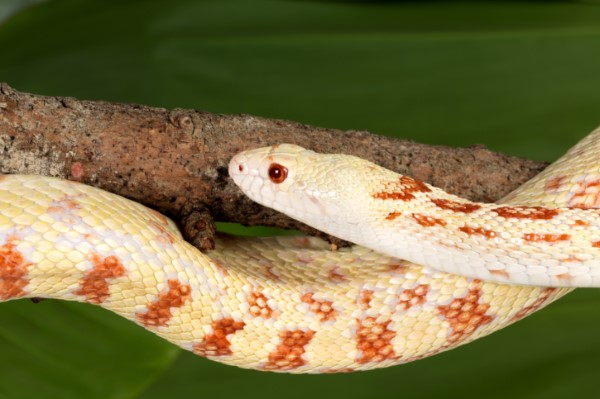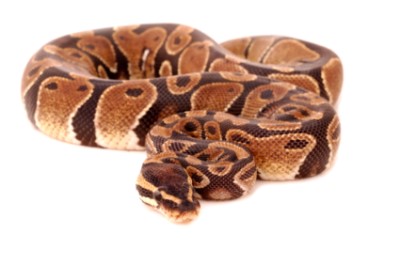Common Reasons for Surrender
The bull and pine snakes are aggressive, and they like to hiss and strike, although they do not always bite. These breeds are not beginner pets because they can be difficult at times.
Pros
The bull snake not only snorts out a great “bull” hiss, but his ability to swell his body to a larger size and posture himself defensively in an “S” shape makes this snake a winner for people that enjoy an impressive scare.
Cons
This snake is secretive but active and will try to climb out of the vivarium home. This snake grows to be strong and strong willed and is not suitable for handling by children. Bulls and pines have become unpopular because they get big, take up space, stink terribly when they go to the bathroom, and their food is expensive.
Diet
Bull snakes like to eat rodents and birds about every seven days. In the wild, a bull snake will slide into the burrows of rodents and dig the prey out of their burrows. Change in weather and temperature may change their eating habits. Feed a baby pine snake (10 to 12 inches at birth sometimes) fuzzy mice, which is a step up from pinky mice. A fuzzy mouse is just starting to form peach fuzz and sometimes bigger than that, as big as a copper mouse which is 1 ½ inches in length. Frozen rodents are recommended because they are bred in captivity, have less chance of parasites, and any parasites that are present will die after 30 days in the freezer. If a snake eats a rodent or bird that has parasites, she will easily get sick.
Exercise
In the wild they travel a lot and in captivity they’re more active, especially in the spring months when it’s breeding season. In winter they are more active.
Possible Health Issues
Internal parasites, mouth rot, external parasites like reptile mites are all pretty common in bull and pine snakes. Reptile mites transfer to fingernails, clothing, and other animals, so people who handle snakes can get reptile mites. Another health problem is that pine snakes can regurgitate if they eat too quickly.
Housing
This snake needs a vivarium 60 x 24 x 24. They like a warm and dry environment, about 75 to 82 degrees. A heating pad under the floor of the vivarium is recommended, but you can also set a heat tape under the bottom of the glass and set the thermostat at 78. This snake needs a thermostat and a heat lamp for basking on one side of the aquarium to keep that dry forest type of habitat. Be sure to provide large, loose wood chips or leaves in the bottom of the cage so the bull snake can burrow underneath.
Grooming
Even though this snake typically does not enjoy bathing, you can mist her with a mist spray bottle occasionally. Misting can be helpful if your snake is experiencing problems shedding. You can also run a wet paper towel up and down the body of pines, bulls, and gopher snakes to help them shed.
Training
Pine snakes can be aggressive when you try to grab them. Some bite, some hiss, while other may be fine with handling. If your snake is aggressive, you will need to use a snake hook to get him out of the vivarium to clean it.
Entertainment
Bull snakes and pine snakes don’t do anything that is impractical. Everything they do is surviving and reproducing. Bull snakes and pines spend a lot of time on the ground in burrows and when they come out they’ll cruise around and look for food or a mate. But they do enjoy basking in the sun, which is vital to every part of their physiological makeup.
ADDITIONAL RESOURCES
For interactive discussion forum go to www.herpcenter.com
http://www.reptilerescuealliance.org/
The Great Big Book of Snakes and Reptiles by Barbara Taylor and Mark O’Shea
We want to thank Metropolitan Herpetological Society, Staten Island, NY, for help with this profile.




